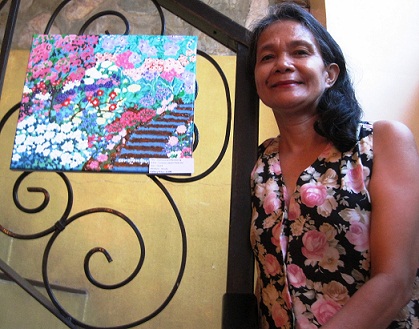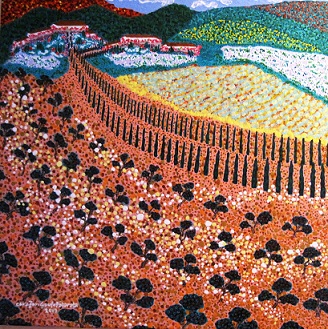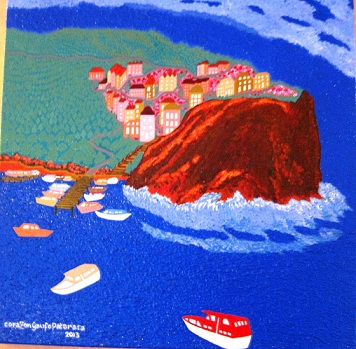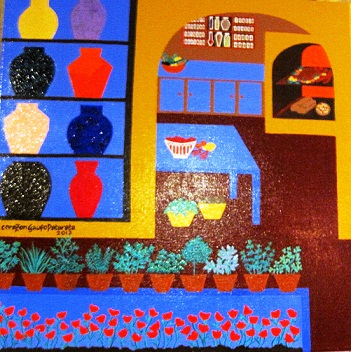Text and photos by ELIZABETH LOLARGA
CORAZON Gaufo Patarata could have risen to the rank of ambassador extraordinary or retired with a similar magisterial title in recognition of her skills, hard work, sacrifice, her having imbibed what true public service meant.
She retired at age 49 in 2006 as minister counsellor, the second highest rank after ambassador. At that point, after postings in Washington DC, Beijing, Bonn, Berlin, Stockholm and Vancouver, she felt that she already had “a full life.”
“ If you add up my working hours, overtime, lost weekends, I had worked more than those who had been working all their lives and were waiting to retire at sixty five,” she rues.
It was time to live her dream of painting and writing, of letting her imagination loose. At her exhibit at Trattoria Poggio Antico Restaurant in Mckinley Hills, Bonifacio Global City, Patarata renders in spring colors and in a charming naïf style her “Mediterranean Sojourn.”
 A Baguio girl, she remembers how hard up her family was. She dropped the idea of studying medicine after graduating magna cum laude with a degree in biology from Saint Louis University. Getting a job became her priority. She worked first as a teacher of science, art and English for Grades 4, 5 and 6 at Maryknoll Baguio. She was a pioneered in teaching an introductory course in physical sciences to sixth graders to prepare them for high school chemistry, physics and biology. Later, a former student told her that she inspired him to be a chemist.
A Baguio girl, she remembers how hard up her family was. She dropped the idea of studying medicine after graduating magna cum laude with a degree in biology from Saint Louis University. Getting a job became her priority. She worked first as a teacher of science, art and English for Grades 4, 5 and 6 at Maryknoll Baguio. She was a pioneered in teaching an introductory course in physical sciences to sixth graders to prepare them for high school chemistry, physics and biology. Later, a former student told her that she inspired him to be a chemist.
At the Philippine Military Academy where she served as an instructor at age 21 and where her students were almost her age, she taught natural sciences. She remembers two students who made good: Ramon Dizon, who was commander of the Presidential Security Group before he retired last year, and Jeff Delgado, commanding general of the Philippine Air Force.
She served as executive assistant to then Minister Vicente Paterno (when the Department of Public Works and Highways was still a ministry) and to Jose Syjuco Jr., deputy minister for planning, administration and finance.
In 1983, she placed second in the Philippine Diplomatic Service exam. Of her decades-long stint at the Department of Foreign Affairs she said, “I spent a lifetime’s worth of energies. I have many memories of meeting colleagues and other people who did excellent work. It’s not an easy job, especially when there are emergency evacuations.”
 She was in China in 1989 when the Tiananmen massacre happened. Filipinos in Beijing had to be repatriated to Manila. She was also in Europe during the war in Yugoslavia and Filipino women and their children with their Serbian husbands had to flee the war zones on foot from Belgrade to the Hungarian border. From there they were brought to the embassy in Budapest, then on to Vienna before repatriation to the Philippines.
She was in China in 1989 when the Tiananmen massacre happened. Filipinos in Beijing had to be repatriated to Manila. She was also in Europe during the war in Yugoslavia and Filipino women and their children with their Serbian husbands had to flee the war zones on foot from Belgrade to the Hungarian border. From there they were brought to the embassy in Budapest, then on to Vienna before repatriation to the Philippines.
Another dramatic experience was when Israel fired rockets into Lebanon in 1998. Patarata worked late to coordinate with the Department of Labor and Employment as she wrote the ban against further travel of Filipinos to either Israel and Lebanon. She went on radio and TV to assure the relatives of overseas Pinoys that the DFA was doing its job.
When she wasn’t working 18-hour days, she studied tourist brochures to get the bus and train schedules and go off for the weekend. She’d leave at 5 p.m. on a Friday and return at 7 a.m. on a Monday with enough time to shower, change her clothes and report for work without her colleagues being aware that she had been away for the weekend.
She preferred doing her own sight-seeing. “If I waited for my colleagues or friends to become available, it’ll take months or it won’t happen at all. It’s hard for people to be available.”
 This was how she explored the Great Wall, saw why photographers, artists and overseas Chinese are mad about the Lijiang River in Guilin province and its breathtaking landscape that includes a mountain range, visited the uninhabited Spirit Island in Alberta, Canada, with seven other passengers on a boat (“There are no structures, no people, no hotels or lodges; it’s clean, green, the waters surrounding it an emerald green”), observed the spinifex grass growing in Australia’s desert mountains, took the Hurtigruten Voyage from Bergen to Kirkenes and back to Bergen in Norway where she stood on the top of the world (“When you’re there and you look at the horizon, the sun is at the eye level; it hangs there permanently and doesn’t rise or set”).
This was how she explored the Great Wall, saw why photographers, artists and overseas Chinese are mad about the Lijiang River in Guilin province and its breathtaking landscape that includes a mountain range, visited the uninhabited Spirit Island in Alberta, Canada, with seven other passengers on a boat (“There are no structures, no people, no hotels or lodges; it’s clean, green, the waters surrounding it an emerald green”), observed the spinifex grass growing in Australia’s desert mountains, took the Hurtigruten Voyage from Bergen to Kirkenes and back to Bergen in Norway where she stood on the top of the world (“When you’re there and you look at the horizon, the sun is at the eye level; it hangs there permanently and doesn’t rise or set”).
She missed seeing the aurora borealis because it was cloudy at the observatory, but the experience of being atop the world and near the North Pole was unbeatable.
Future painting subjects are people, their emotions and rare Philippine destinations like Siargao and Batanes that she still has to visit.

